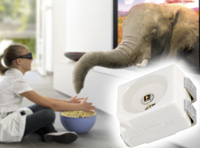
| Home | About Us | Contribute | Bookstore | Advertising | Subscribe for Free NOW! |
| News Archive | Features | Events | Recruitment | Directory |
News
8 November 2010
Osram’s stack chip technology doubles output of infrared Power TOPLEDs
 Osram Opto Semiconductors GmbH of Regensburg, Germany says that its new Power TOPLED SFH4250S emits almost double the infrared light compared to its standard component SFH4250.
Osram Opto Semiconductors GmbH of Regensburg, Germany says that its new Power TOPLED SFH4250S emits almost double the infrared light compared to its standard component SFH4250.
The new IR-LED achieves a radiant intensity of typically 22mW/sr and a total radiant flux of 70mW in continuous operation at a driving current of 70mA, allowing the design of very compact lighting units. Also, in existing designs the effective range can be increased significantly. 3D TV sets comprise one of the possible applications that benefit from the improvement.
Osram Opto attributes the increase in performance to its stack technology for thin-film chips. Last year the stack technology was introduced to large-scale 1mm2 chips, featuring a serial connection of two p-n junctions rather than one p-n junction and almost doubling performance. The technology has been applied to chips with an edge length of 300µm for the SFH4250S.
“With this combination of well-proven chip design and standard packages, our customers can make use of our enlarged portfolio of powerful IR emitters without having to change their design,” notes Harald Feltges, marketing manager for Infrared Components. The new Stack Power TOPLED allows pulsed operation up to 1A pulse current, reaching 220mW/sr radiant intensity and 700mW total radiant flux.
“Above all, applications in which compact lighting units illuminate large areas with infrared light benefit from this new component,” says Feltges. A typical example are 3D TV sets: the synchronization of shutter glasses with the television picture is achieved by powerful IR emitters which illuminate the area in front of the TV set up to a distance of 7m. “The new Stack Power TOPLED almost halves the number of required IR-LEDs per set, or it improves the range of existing designs, respectively,” he adds.
With a wavelength of 850nm, the emitted light of the SFH4250S is not visible to the naked eye, neither does it interfere with the remote control, which works at about 950nm. Many computer games make use of the 3D technology too, benefiting from the new IR emitters. The increased IR power also generates advantages in vehicle safety systems, mainly in seat occupancy detection systems for airbag activation and driver monitoring systems to enable fatigue detection (Drowsy Driver System).
Osram Opto says that the stack technology for thin-film chips has been proved and tested in many applications, from night-vision systems in vehicles to sensors in mobile end-user devices, the latter benefiting in particular from the efficiency of stack chips.
Visit: www.osram-os.com
For more: Latest issue of Semiconductor Today